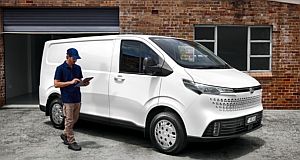Overview
The launch of the fully electric LDV eDeliver 7 range could be a significant turning point for the brand in Australia, and the medium-size van market more generally.
With assertive starting pricing that undercuts its only electric rival, the Mercedes-Benz eVito, by more than $30,000, the new electric van from LDV starts at just $59,990 and tops out at $66,990 (+ORCs, for ABN holders).
This EV van is playing right in the heartland of the diesel-dominated segment, and while it might cost a little more than an equivalent Hyundai Staria Load, Toyota HiAce or Ford Transit Custom, it offers potentially huge savings for ongoing ownership costs.
You’ll never have to think about your time and money wasted going to get fuel (and a snack) on the way to a job ever again, and for back-to-base fleets that could also mean significantly less paperwork if there’s charging onsite.
Plus, there are some impressive long-term ownership considerations, including a five-year/160,000km warranty for the van and an eight-year/250,000km warranty for the battery pack.
There’s also capped-price servicing for six years/90,000km, for a grand total of about $1165… for the entire period. Some other vans would cost about that much per 30,000km of driving.
Those long intervals also mean less downtime for your business vehicle. A Toyota HiAce, for example, needs maintenance every six months/10,000km. If you’re a high miler, that time loss adds up.
All four takes on the theme have 11kW maximum AC charging capability, meaning a 5-100 per cent charge time of approximately eight hours for the 77kW model, and 9 hours 20 mins for the 88kWh versions.
There’s a difference for DC charging, too, with the smaller-battery models boasting max DC charging of 78kW, and the bigger-battery versions capable of 90kW. However, LDV says both should manage 20-80 per cent charging in about 43 minutes.
It also has a pretty decent array of standard equipment, including automatic LED headlights, daytime running lights and tail-lights, rain-sensing wipers, 16-inch steel wheels, a full-size spare, tyre pressure monitoring, vinyl flooring (rubber floor in cargo area), cloth seat trim, heated front outboard seats, heated steering wheel, 12.3-inch touchscreen media system with Apple CarPlay and Android Auto, keyless entry and push-button start, and more.
However, as a work vehicle, it mightn’t suit all needs, because the standard arrangement is a kerbside sliding door, and barn doors at the back.
That seems a good offer for most, but you cannot opt for glazing for the rear panels, nor can you get it with a tailgate, and while there is the provision for a driver’s side sliding door, it’s not available either. And you can’t option a bulkhead, but a cargo barrier is available as an accessory.
So, it’s certainly not as customisable as a VW Transporter, for instance, but the brand had to keep the complexity down in order to achieve the price point this van is offered at. And with payload capacity ranging from 1175kg to 1350kg, it has the on-paper chops to do the job. But is it good to drive?
Driving impressions
Off the bat, you need to know that this test wasn’t what you might do as a delivery driver or tradie. It was a run from the west of Sydney to the north shore and back, in a mix of different traffic conditions, with no load to speak of.
So, you might expect to see worse energy consumption than I did (SWB Low Roof 22.1kWh/100km) if you load it up to the max capacity.
I also tested the more aerodynamically challenged LWB High Roof model, which was displaying a probably-optimistic 389km of EV range at the commencement of the drive, and returned a displayed 23.9kWh/100km over a mix of urban, highway and freeway driving.
As you would expect of an electric van, the good elements include effortless pulling power and urgency when under sudden acceleration, with even the most sedate Eco mode offering decent response. In Normal mode it is quicker, while Power is far zestier in its responsiveness.
Other things that will come as music to the ears of all-day drivers is the fact there’s no engine vibration or noise, no rattly restarts, and no transmission quirks either, as the single-speed auto is all about predictable propulsion. The only thing that will take some learning is the shifter placement, which is where you might be used to indicating, not going from R to D.
The short launch drive showcased that this is a van designed for dealing with big loads, and as such it exhibits a firm ride in both the SWB and LWB models when unladen. That is to be expected, with leaf springs at the back designed to do a job, but also predictably the longer-wheelbase model was better at dealing with the little lumps and bumps in the road surface than the SWB model.
Most vans are great when it comes to steering responsiveness and accuracy, and the eDeliver 7 also falls into that category. It has a nicely accurate response for parking moves and negotiating roundabouts and feels stable and controlled at higher pace in straighter lines, too – but replacing those Giti Van tyres might be a cost-effective upgrade for the eager owner as they aren’t the grippiest.
It’s a big rig, and while it has standard front and rear parking sensors and reversing camera, it’s surprising there is no surround-view system, since it would be a huge advantage, and it’s standard in UK-spec models. Those panels in the back make parking a bit of a guessing game in some situations.
And while it is an EV, so the powertrain is nearly silent aside from a rather endearing tonal humming at start-up, there’s also plenty of noise to contend with from around the top of the windscreen in the High Roof model, and it and the lower version still had a bit of wind rustle around the windows and mirrors, too, not to mention the expected echo-chamber effect without a load or bulkhead.




